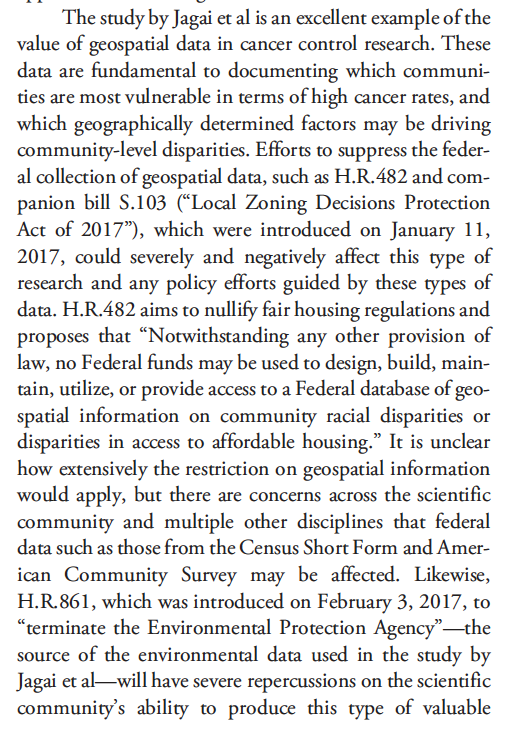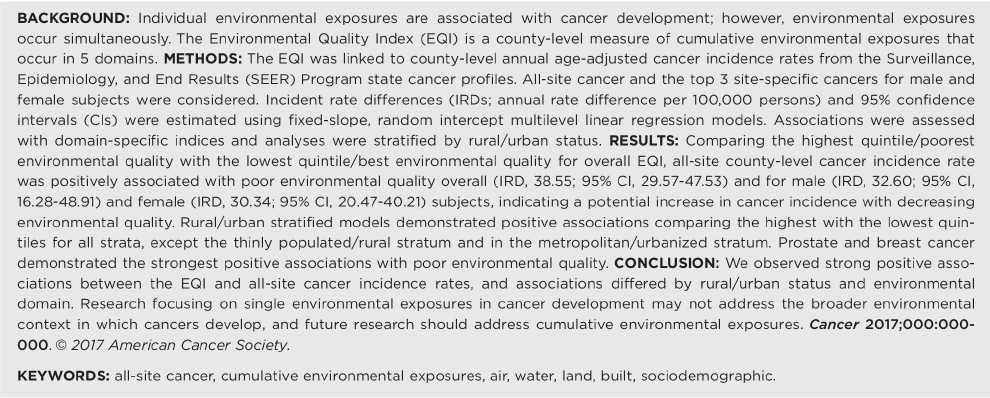Does a new study link “pollution” with cancer — or the just junkiest of statistics with opponents of EPA budget cuts?

The study (see below) purports to statistically (not scientifically) associate urbanized environments with slightly higher incidence of cancer. No specific cancer is linked with any specific substance or condition in the environment. There are no exposure data in the study. It is just rank correlation that does not actually anything with anything else.
The more interesting part of the study is in the media release:
Likewise, the authors warned that H.R.861, a bill introduced in February 2017 to terminate the Environmental Protection Agency, the source of the environmental data used in this study, will have severe repercussions on the scientific community’s ability to produce research on the factors that contribute to disease in vulnerable communities. “These data are essential to cancer control and the public’s health,” the authors note.
So the study is really a hit on the Republican efforts to rein in EPA. Who’s behind this hit?
Here are the study authors:

Here are their affiliations:

So four of the six study co-authors Kristen M. Rappazzo, Chris L. Gray, Shannon C. Grabich and Danelle T. Lobdell work for… the Trump EPA.
Aside from trying to sabotage GOP efforts to rein in EPA, this effort may violate the Anti-Lobbying Act (18 USC Section 1913), which governs lobbying on legislation by federal employees.
Also, an editorial accompanying the study also veers off into political science.


The media release and abstract are below.
###
Poor environmental quality linked to elevated cancer rates
WILEY
Experts warn that recent legislative proposals could jeopardize research on the links between cancer and the environment.
A new study reveals an association between cumulative exposure to harmful environmental factors and cancer incidence across the United States, with prostate and breast cancer especially demonstrating strong links with poor environmental quality. Published early online in CANCER, a peer-reviewed journal of the American Cancer Society, the findings may help to reduce the burden of cancer by allowing officials to identify vulnerable communities in need of attention.
To investigate the effects of overall environmental quality across multiple domains — including air, water, and land quality; sociodemographic environment; and built environment — Jyotsna S. Jagai, MS, MPH, PhD, of the University of Illinois, Chicago, and her colleagues linked the Environmental Quality Index, a county-level measure of cumulative environmental exposures, with cancer incidence rates from the Surveillance, Epidemiology, and End Results Program State Cancer Profiles.
The average annual county-level age-adjusted incidence rate for all types of cancer was 451 cases per 100,000 people. Counties with poor environmental quality demonstrated a higher incidence of cancer cases–on average 39 more cases per 100,000 people–than counties with high environmental quality over the study period. Increased rates were seen for both males and females, and prostate and breast cancer demonstrated the strongest positive associations with poor environmental quality.
“Our study is the first we are aware of to address the impact of cumulative environmental exposures on cancer incidence,” said Dr. Jagai. “This work helps support the idea that all of the exposures we experience affect our health, and underscores the potential for social and environmental improvements to positively impact health outcomes.
Dr. Jagai noted that research has traditionally focused on individual environmental exposures, which is important for understanding specific mechanisms that can cause disease; however, cancer development is dependent on the totality of exposures people face, including social stressors. “Therefore, we must consider the overall environment that one is exposed to in order to understand the potential risk for cancer development,” she said.
An accompanying editorial notes that the study is an excellent example of the value of geospatial data in cancer control research. “These data are fundamental to documenting which communities are most vulnerable in terms of high cancer rates, and which geographically determined factors may be driving community-level disparities,” the authors wrote. They also stressed that recent legislative proposals that seek to suppress the federal collection of geospatial data, such as the Local Zoning Decisions Protection Act of 2017, which was introduced in January 2017 and seeks to prohibit the use of Federal funds for the collection of geospatial data on racial and community disparities, could severely and negatively impact this type of research and policy efforts guided by these types of data.
Likewise, the authors warned that H.R.861, a bill introduced in February 2017 to terminate the Environmental Protection Agency, the source of the environmental data used in this study, will have severe repercussions on the scientific community’s ability to produce research on the factors that contribute to disease in vulnerable communities. “These data are essential to cancer control and the public’s health,” the authors note.
###
Additional information
Full Citation: “County-level cumulative environmental quality is associated with cancer incidence.” Jyotsna Jagai, Lynne Messer, Kristen Rappazzo, Chris Gray, Shannon Grabich, and Danelle Lobdell. CANCER; Published Online: May 8, 2017 (DOI: 10.1002/cncr.30709).
URL Upon Publication: http://doi.wiley.com/10.1002/cncr.30709
Editorial: “Impact of the environment on cancer: seeing the forest for the trees.” Scarlett Lin Gomez, Salma Shariff-Marco, Iona Cheng, and Peggy Reynolds. CANCER; Published Online: May 8, 2017 (DOI: 10.1002/cncr.30711).
URL Upon Publication: http://doi.wiley.com/10.1002/cncr.30711
About the Journal
CANCER is a peer-reviewed publication of the American Cancer Society integrating scientific information from worldwide sources for all oncologic specialties. The objective of CANCER is to provide an interdisciplinary forum for the exchange of information among oncologic disciplines concerned with the etiology, course, and treatment of human cancer. CANCER is published on behalf of the American Cancer Society by Wiley and can be accessed online at http://wileyonlinelibrary.com/journal/cancer.
About Wiley
Wiley, a global company, helps people and organizations develop the skills and knowledge they need to succeed. Our online scientific, technical, medical, and scholarly journals, combined with our digital learning, assessment and certification solutions help universities, learned societies, businesses, governments and individuals increase the academic and professional impact of their work. For more than 200 years, we have delivered consistent performance to our stakeholders. The company’s website can be accessed at http://www.wiley.com.
###

Venus: It is not that amount of CO2 (%Vol) that makes Venus so hot, it is the amount of CO2 (absolute mass).
Mars: Flip it for Mars — It isn’t the %Vol that make Mars so cold, it is the lack of mass.
0.04%== 0.0004 The joyous challenges of representing percentages on screen, in our brain and in a calculation.
The dance. The neverending dance.
“Numerous studies in the fields of heart disease and diabetes have shown the benefits of nut consumption”
Yea. right.
“Peanuts and peanut butter—the most commonly consumed nuts in the United States—did not appear to have any significant effect.”
Disease discriminates against peanut butter. Who’d have thought.
TRILLIONS of PUBLIC Dollars Spent on Conclusions Reached Based Upon “Made Up Data.”
It turns out that the “expert scientists” literally “make up” the data (see introductory graphic). Taxpayers are literally being asked to spend trillions of dollars based upon models that use “made up” data. Unfortunately, that isn’t a joke. The total cost including direct, indirect and opportunity costs is simply staggering.
https://co2islife.wordpress.com/2017/05/14/trillions-of-public-dollars-spent-on-conclusions-reached-based-upon-made-up-data/
Green Economics: Hire People To Push Busses
https://co2islife.wordpress.com/2017/05/14/green-economics-hire-people-to-push-busses/
Ocean Warming Dominates The Increase In Energy Stored In the Climate System
The IPCC claims that the oceans are by far the largest heat sink in the climate system. The IPCC claims that the oceans are warming. Data proves the oceans drive atmospheric temperatures, not vice verse. The problem is, the IPCC can’t explain how CO2 warms the oceans. If the IPCC can’t explain how CO2 is warming the oceans, it can’t explain how/why the atmosphere is warming.
https://co2islife.wordpress.com/2017/05/13/ocean-warming-dominates-the-increase-in-energy-stored-in-the-climate-system/
4 Graphs That Demonstrate Why The IPCC Climate Models Will NEVER Be Accurate
If I am correct in properly identifying the motives and intent of the fraud, the divergence between the ground measurements and satellite data will continue to widen with time. In 10 years, an understanding of the crime detailed above and an update of the following chart is all Congress should need to present an open and shut case against the climate alarmists that have defrauded the American taxpayers, corrupted real science, and destroyed the credibility of our media and educational system.
https://co2islife.wordpress.com/2017/05/13/4-graphs-that-demonstrate-why-the-ipcc-climate-models-will-never-be-accurate/
Some simple math (but too complex for global warming proponents and followers:
Earth’s CO2 is .0004 percent of the atmosphere.
Mars atmosphere is 95 percent carbon dioxide.
Mars is much, much colder than Earth. Obviously, there are other more important factors besides CO2 that determine temperature and climate.
But you can’t get rich hyping the other factors…
CO2 Can’t Cause the Warming Alarmists Claim it Does
In conclusion, if you break the data down to isolate the impact of CO2 on atmospheric temperatures, there simply isn’t a strong case to be made that CO2 is the cause of the warming. Yes the oceans are warming, yes temperatures have been warming, but that doesn’t mean CO2 is the cause of that warming. If you isolate the impact of CO2 by removing the impact of the oceans, the urban heat island effect, and atmospheric water vapor, the result is that those areas show no warming what so ever. CO2 increased from 335 ppm to 405 ppm in Antarctica, and it had no impact at all, none, nada, zip.
https://co2islife.wordpress.com/2017/05/10/co2-cant-cause-the-warming-alarmists-claim-it-does/
But…the science is settled — except when it isn’t: https://www.usgs.gov/news/ocean-absorption-carbon-dioxide-more-makes-methane-emissions-seafloor-methane-seeps
Oh, I am so surprised to read this.
“So four of the six study co-authors Kristen M. Rappazzo, Chris L. Gray, Shannon C. Grabich and Danelle T. Lobdell work for… the Trump EPA.”
Think how much money we could save if the EPA had four fewer employees.
If Obama was president, they would be fired. If Hillary was president, well, you know the rest…..
Whatever happened to the scientific method. Whatever happened to the idea that other scientists should be able to duplicate your findings. Whatever happened to the idea that good science should establish a feeling of confidence in our citizenry.
The EPA is just another corrupt gov agency
The same technique of simple statistical association with one (out of many) subjectively selected possibly relevant contributing factor is the basis for the global warming scare.
Congress Should Investigate the Peer Review and Publication Process
It is almost unfathomable to believe that a survey performed through a simple search of journal articles performed by a “researcher” with an Anti-Trump book in the works can be justification for spending TRILLIONS of US taxpayer’s dollars.
https://co2islife.wordpress.com/2017/05/08/congress-should-investigate-the-peer-review-and-publication-process/
50 years ago my grandmother explained ‘rising cancer rates’ quite succinctly: “People didn’t used to live long enough to get cancer.”
The worst aspect of such papers are that they statistical show “linkage”, that is coincidence, but imply causality – at Best extremely poor science and incompetence but at worst deliberate falsification.
This is the heart of today’s politicised research community, what needs to change is the education of and enforcement of scientific integrity.